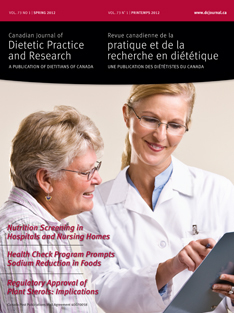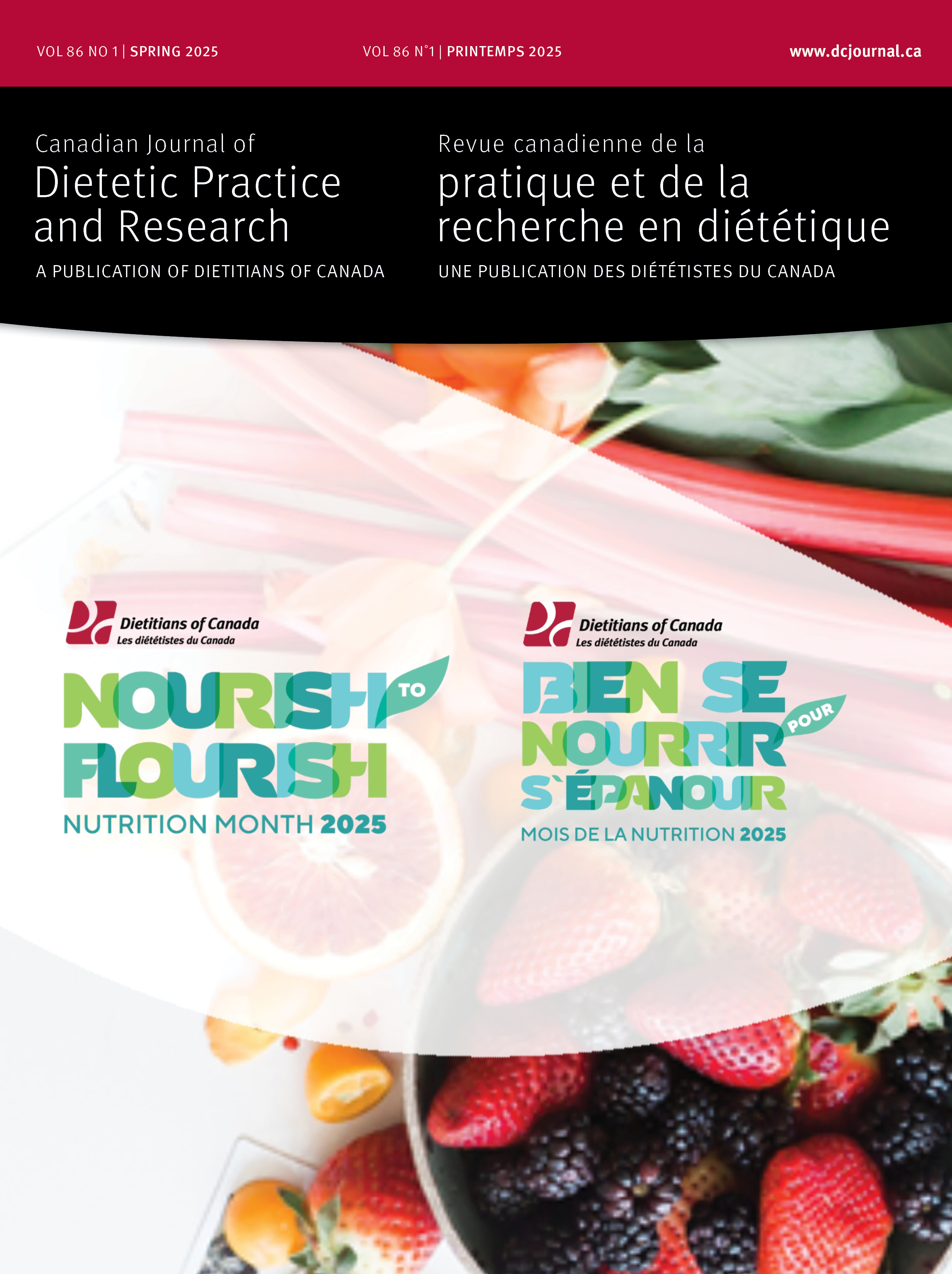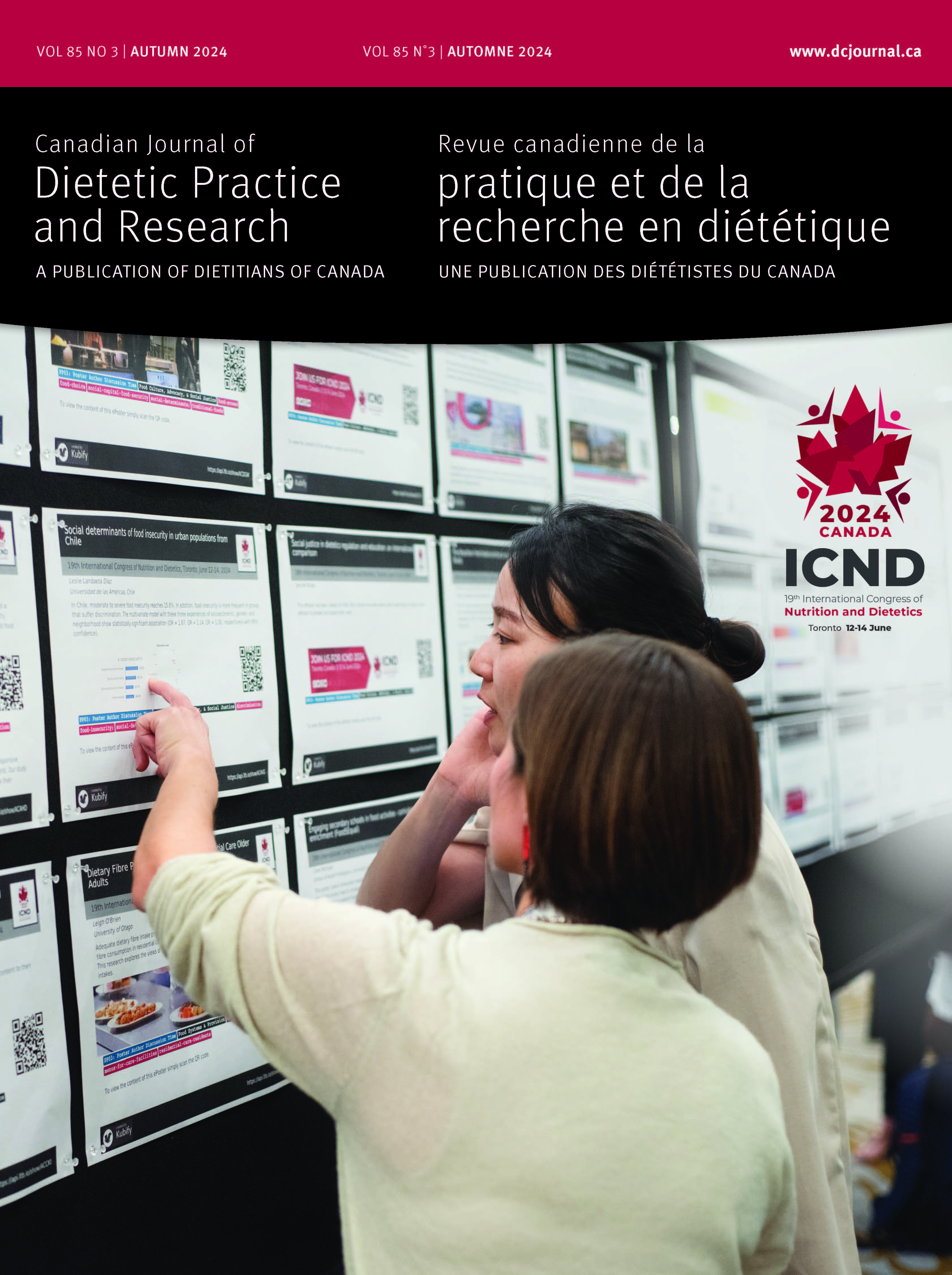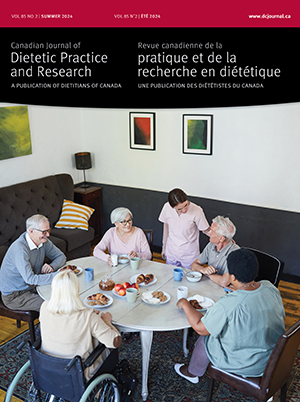Volume 73 • Number 1 • March 2012
Chair’s Message
Editor’s Message
Research
Purpose: Students’ identity development and professional socialization during dietetic education were explored. Methods: Thirteen undergraduate dietetic students from two universities completed three in-depth interviews based on Seidman's phenomenological approach. The students were at various stages of their education. Data were analyzed with a feminist form of inductive thematic analysis. Results: Dietetic students come to the educational process with a broad interest in health, helping, or foods and nutrition. The academic and practical components of dietetic education create opportunities for students to refine personal interests in order to (re-)envision their place within the profession. The complexity of professional socialization and identity development was illuminated as some students’ focus was redirected to becoming an intern rather than becoming a dietitian. Students transformed their identity to meet the requirements they thought were expected or necessary to obtain an internship. Internship competition and the program environment can influence this transformation. Conclusions: Professional identity development begins before dietetic education and develops within the context of that education, representing the intersection of both people and events. A recognition and understanding of these complexities can result in strategic recruitment, informed curriculum changes, and professional development opportunities for dietetic educators, which will enhance their ability to support students in the professional socialization process.
Purpose: We examined dietary intakes among Nova Scotia youth, and analyzed whether these intakes met existing dietary guidelines. Methods: Data from 1469 students in grades 7 and 11 from randomly selected schools were collected via a web-based dietary assessment tool, including a 24-hour recall. Nutrient analysis products were subjected to descriptive and inferential statistical analyses. Results: Reported dietary intakes across sexes and grades showed the vast majority of youth did not meet minimum recommendations for fibre (96% to 98%) or vegetable and fruit servings (83.3% to 90.7%). Girls in grade 11 reported greater intakes of folate and lower intakes of saturated fat, and were less likely to report iron intakes at or above the Estimated Average Requirement than were grade 7 girls. Across ages, more than 75% of girls reported low calcium and folate intakes. Boys in both grades reported consuming more energy than did girls, and older boys reported consuming more than did younger boys. Foods outside the four main food groups contributed about 25% of total reported energy intake. Students in grade 7 consumed pop, salty snacks, and french fries more frequently than did students in grade 11. Conclusions: Adolescents’ self-reported dietary intakes may not meet current dietary recommendations. Continued efforts are needed to develop innovative strategies to ensure healthy eating patterns.
Objectif: Cette étude avait pour but de décrire différentes composantes de l’environnement alimentaire en milieu de garde. Méthodes: Trente-trois centres de la petite enfance (CPE) de la région de l’Estrie (Québec, Canada) ont été visités. Les données ont été recueillies entre mars et juillet 2008 à l’aide d’un questionnaire inspiré du modèle de Cohen. Ce questionnaire visait à recueillir des renseignements sur l’organisation des repas, la composition du menu et les modes de préparation des aliments. Résultats: Bien que peu de CPE aient adopté une politique alimentaire, les analyses descriptives ont mis en évidence que l’environnement alimentaire y était généralement adéquat. Dans 97 % des CPE, la planification du menu était effectuée par le responsable de l’alimentation. L’offre de repas de même que les modes de préparation des aliments s’avéraient cohérents avec les consignes générales du Guide alimentaire canadien (GAC). Cependant, un manque de formation professionnelle a été observé. Par ailleurs, seulement 25 % des CPE offraient une collation composée de deux groupes alimentaires. Conclusions: Certaines améliorations doivent être apportées sur le plan de l’environnement alimentaire en milieu garde au Québec, ce qui souligne la nécessité d’élaborer et d’implanter une politique alimentaire pour les services de garde.
Purpose: The current Health Check criteria were examined, to evaluate their influence on prompting licensees to reduce sodium in their participating products from 2004 to 2008. In addition, the impact of the new Health Check criteria, implemented in November 2010, was explored. Methods: Over three months, 14 Health Check program licensees representing 371 products completed a researcher-administered questionnaire, either in person or via conference call. The data were recorded, reviewed, and calculated. Participants verified the data after the interview. Results: The current criteria prompted product reformulations and new formulations among Health Check participants. One hundred and fifty products had sodium reduced to meet the current Health Check criteria, for a total reduction of over 322,000 kg of sodium. New formulations comprised 116 products; the remaining 105 products met the current criteria. Two hundred of the 371 Health Check products that had been reformulated, that met the criteria, or that were new formulations already meet the new 2010 Health Check criteria. Conclusions: The Health Check program prompted participants to reformulate existing products or formulate new products to meet the criteria for sodium. All participants agreed that the new 2010 Health Check criteria will affect them.
Purpose: Dietitians of Canada has collaborated with experts in knowledge translation and transfer, technology, and dietetic practice to develop and implement an innovative online decision-support system called Practice-based Evidence in Nutrition (PEN). A study was conducted to evaluate the perceived facilitators and barriers that enable dietitians to use or prevent them from using PEN. Methods: As part of the overall evaluation framework of PEN, a qualitative descriptive research design was used to address the research purpose. Individual, semi-structured telephone interviews with 17 key informants were completed, and the interview transcripts underwent qualitative content analysis. Results: Respondents identified several facilitators of and barriers to PEN use. Facilitators included specificity to dietetics, rigorous/ expert review, easy accessibility, current content, credible/ secure material, well-organized/easy-to-use material, material that is valuable to practice, and good value for money. Barriers included perceived high cost, fee structuring/cost to students, certain organizational aspects, and a perceived lack of training for pathway contributors. Conclusions: This formative evaluation has indicated areas in which PEN could be improved and strategies to make PEN the standard for dietetic education and practice. Ensuring that PEN is meeting users’ knowledge needs is of the utmost importance if dietitians are to remain on the cutting edge of scientific inquiry.
Perspectives in Practice
Health Canada’s recent approval of plant sterols as food ingredients to decrease low-density lipoprotein cholesterol (LDL-C) is believed to be a significant step toward improving Canadians’ cardiovascular health and reducing the economic burden of heart disease. When dyslipidemic patients consume plant sterols at a recommended daily dose of 2 g, they can reduce LDL-C by 10% to 15%, with no deleterious effects on high-density lipoprotein cholesterol. A 10% LDL-C reduction in response to plant sterol consumption is projected to reduce heart disease risk by 25%. Because they are available without a prescription, plant sterols are an option for dietitians who wish to provide cholesterol-lowering guidance beyond traditional dietary advice (i.e., lowering saturated fat intake and restricting dietary cholesterol). In addition, plant sterols can be used in combination with a statin or when statin use is contraindicated, and they have recently emerged as a potentially valuable triglyceride-lowering option. However, the projected improvement in public health and health care savings will be realized only if impediments to daily use are removed. One such impediment is the higher cost of fortified food products, such as yogurt and margarine. If the cost of plant sterol food products is to decline, cost-effective sources must be investigated and a larger range of foods containing plant sterols must be made available.
We explored the availability of parameters for a nutrition screening system among elderly people in New Brunswick (NB) health care facilities. Patients aged 65 or older were asked to participate in the study; each participant had been admitted to one of four hospitals or lived in one of six nursing homes. Availability of nutrition screening parameters (weight, height, weight change, serum albumin level, appetite, and food intake record) was assessed by auditing the participants’ medical charts. When data were not available, the feasibility of obtaining them was determined. Additional data related to nutrition screening were also obtained. In total, 421 participants were recruited for the study: 140 (33.2%) who lived in nursing homes and 281 (66.8%) who were in hospitals. Parameters needed to conduct nutrition screening, such as weight upon admission, were available for 83.6% of participants; usual weight was available for 43.0%, height for 86.0%, and serum albumin level for 47.5%. Our findings show that basic parameters for nutrition screening are available, and that implementation of a nutrition screening system is feasible for patients in NB health care facilities.
Efforts to support workforce development led to the launch of a new master of public health program aimed at improving access to graduate studies for practising nutrition professionals. The first cohort of students identified employer support as a key determinant of their success. In order to identify ways of addressing both student and employer needs, we explored the perspectives of students’ employers. Seventeen in-depth, semi-structured, open-ended interviews were conducted with employers. Interviews were audiotaped and transcribed. Transcripts were organized using NVivo software and coded thematically. All employers indicated support for employee education and development in principle, but most faced practical challenges related to limited staffing during education leaves. Organizational policies varied considerably across employer groups. Collective agreements that guided education policy were seen to ensure consistent support for employees, but also to limit creative approaches to education support in some situations. Employers highly valued graduate student projects that were directly related to the workplace; these projects presented opportunities for collaboration among the university, students, and employers. Universities need to work with employers and other stakeholders to identify ways of overcoming barriers to public health nutrition graduate education and workforce development.
Report
Purpose: Little is known about dietary intakes in toddlers of Low-German-Speaking Mennonites from Mexico, although some of these toddlers might be at risk for nutritional deficiencies. A 97-item, culturally sensitive, interviewer-administered food frequency questionnaire (FFQ) was developed and validated for health professionals to assess dietary intake in these children aged 12 to 36 months. Methods: Cultural foods on the FFQ were determined via focus groups; a pilot study tested content and formatting. The FFQ was administered to parents/caregivers of 22 toddlers in a southern Ontario community of Low-German-Speaking Mennonites from Mexico. Validity was determined by comparing nutrient intakes from the FFQ and from the 24-hour recalls, using Bland-Altman plots, Pearson correlations, and Student’s t-tests. Test-retest reliability was compared between two FFQ administrations (n=14) one month apart, via intraclass correlations (ICCs). Results: Bland-Altman plots showed good agreement between the FFQ and the 24-hour recall; Pearson correlations between methods were significant for protein, folate, calcium, and caffeine. Student’s t-tests were not significantly different between methods for 11 of 12 nutrients. Test-retest reliability was good on the basis of acceptable ICC for eight of 12 nutrients. Conclusions: The prevalence of nutrient inadequacies was low, except for folate. These results are promising for implementation of a simple, quick, culturally sensitive FFQ with the potential to provide reliable estimates of mean intakes in toddlers of Low-German-Speaking Mennonites from Mexico.
Purpose: The study was conducted to evaluate whether body fat is a better measure than body mass index (BMI) for determining the relationship between body size and sweetness perception and preference. Methods: Seventy-two women were recruited and separated into two groups. First, BMI was determined and used to classify each woman as either normal weight (18.5 to 24.9 kg/m2) or overweight (>25.0 kg/m2). Body fat was determined from skinfold sites and used to categorize women into normal (<26.0%) or overweight body fat (≥26%) groups. Detection thresholds were determined using sucrose solutions. Four custard samples that varied in sweetness were evaluated to determine the women's liking for sweetness, and the perceived sweetness of the sample. Results: Women in the overweight BMI and body fat groups had higher sucrose threshold values than did women in the normal groups. When presented with custards of varying sucrose levels, the overweight BMI and body fat groups had a significantly increased liking for sweetness as sucrose concentration increased. Conclusions: Body fat measures were as effective as BMI measures in determining sweetness preference. Future research should be conducted to determine whether body fat and measures, such as waist circumference, can be predictive tools for sweetness preference.










